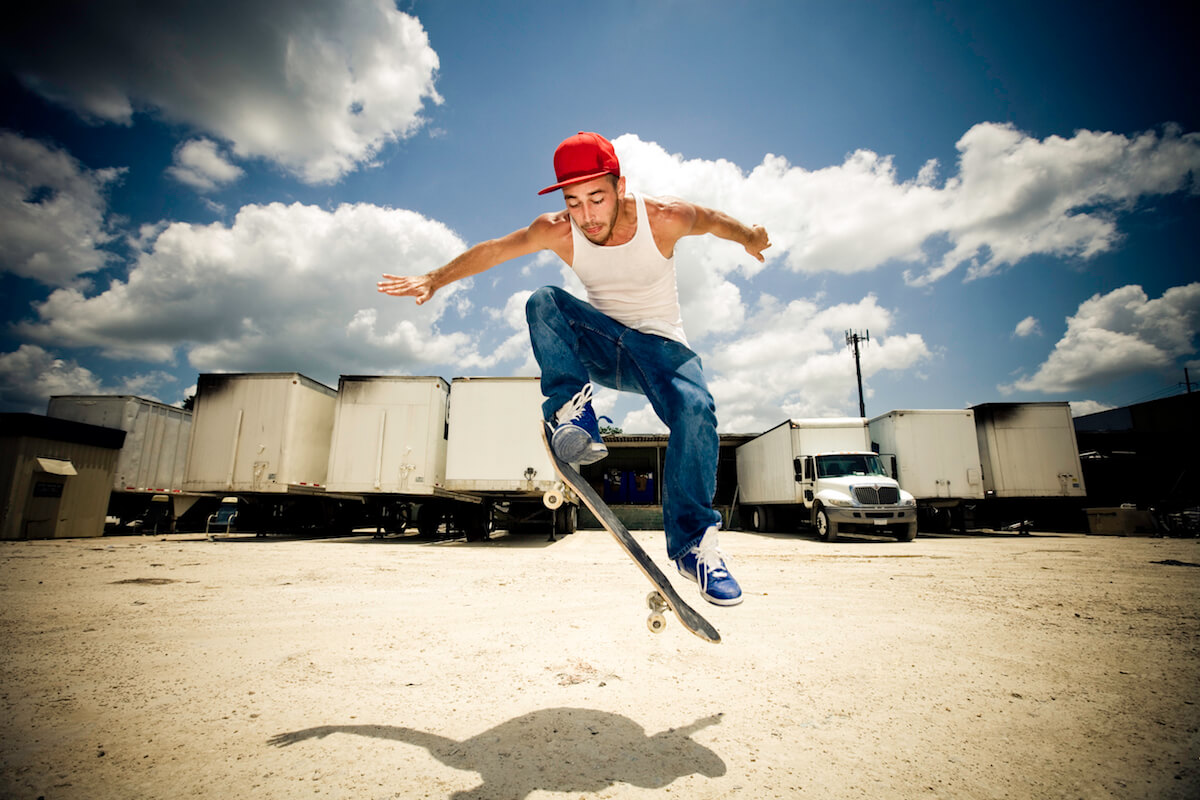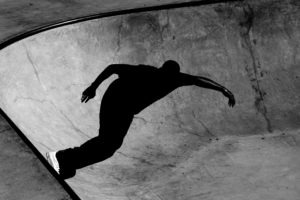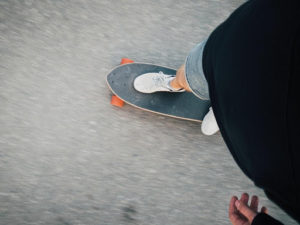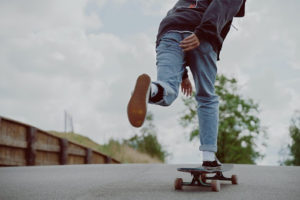If you’ve ever watched a skateboarder roll down the street and then all of a sudden pop into the air on a skateboard, you’re probably wondering the same question a lot of people do: how on earth do they do that? It almost seems magical how they just seem to explode off the ground, and then just kind of float. Skateboarder, meet, the ollie. It’s not in the category of “easy skateboard tricks,” but if you learn how to ollie, you’re well on your way to fame and fortune as a professional skater.
History of the Ollie
Before we show you how to ollie, let’s get familiar with the legends that brought this skateboard trick to the masses. If it were a person, the history of ollie would start way back in 1974, when Alan Gelfand got his first skateboard from his father after his family moved to Hollywood, Florida from New York state. It didn’t take him too long to get the hang of it; he won the South Florida Skateboard championships two years later.
In 1977, skate parks began cropping up all over the place, including Skateboard USA, where Gelfand began to spend most of his time. His buddy, Scott Goodman, is the one who gave Gelfand the nickname of “Ollie” and dubbed his aerial lipside the “ollie-pop.” Pictures of Gelfand during this time period clearly show him getting airborne and performing the trick associated with his name today.
It wouldn’t be until the early 1980’s however, that a man named Rodney Mullen fully developed the skateboard ollie and brought it into vogue. Competing in the Rusty Harris contest in Whittier, California in 1982, Rodney Mullen used a back and forth motion on his skateboard to strike the back end of the board on the ground and using the front end to level the board out in mid-air – all from a flat surface. The audience’s jaws collectively hit the ground.
No one had ever seen anything quite like it before, but no one knew just how transformative that moment would become. It wasn’t just that you could simply pop up into the air, it’s that it gave the rider a whole other set of opportunities to do tricks, and you don’t even have to be dependent on a ramp! As time went by, people began to add other skateboard tricks while they were airborne.
Oh yeah, Rodney Mullen won the Rusty Harris contest that year too, and also had an impromptu demonstration of his trick afterwards for anyone that wanted to learn. It debuted later that year in the popular skateboarding magazine “Thrasher” under the name “Ollie-pop.” Thus, the history of ollie was formed.
Types of Ollies
Today, many riders use the “ollie-pop” on more than just the flat-level surfaces in between other tricks, it’s used heavily in the half-pipe and bowl ramps to allow the rider to go even higher in the air. Performing the “ollie-pop” while you’re at or near the top of the lip is a great way to get an extra couple feet, which might be all you need to get that extra turn in and nail the 720 (or 900, if you’re Tony Hawk).
On top of that, different types of ollies have appeared over time, such as:
The Nosegrab Ollie
You do a typical jump, but instead of just kinda hanging there in the air, reach down and grab the front end of the board. It takes a remarkable amount of concentration though, not just to stick the landing, but to not crush your board and drill your head into the ground in the process.
The Nollie
The nollie is confused with the fakie ollie, but is different in one key area: instead of using the back foot to launch the board up, and then levelling off with the front foot, the nollie is performed by pushing off with the front foot and using the back foot to level off, essentially doing the trick in reverse.
The Fakie Ollie
The Fakie is almost the same thing as a regular ollie-pop, but instead of going forward, the skater is going backwards when they pop the board up in the air, usually performed when you’re in a switch stance. A switch stance is when your feet are in the opposite stance of how you normally would stand, like when you write with your left hand instead of your right (if you’re right-handed).
Frontside 180
The frontside 180 is a natural progression from the regular skateboard ollie. The motion is pretty much the same, except when you land, you are now pointed 180 degrees the other direction, riding fakie. The board is still going in the same direction, but your body is facing where you came from.
Backside 180
The backside 180 is not that different from the frontside, but the difference is in which direction you turn. For the backside, you turn to the side your back is facing, pretty much making you unable to see where your landing is. For a frontside, you turn in the direction you’re already facing.
There are other types of ollies that you can do either alongside or combine with the ones listed above, like the tailgrab, indy grab, melon grab, stalefish, tweak, and dolphin nose. All of those skateboard tricks are performed more or less how they sound, but you might want to watch some videos on youtube to see a pro in action (as well as awesome cat videos).
Tips on how to Ollie
So you want to know how to ollie? Be warned, it’s not for the faint of heart, and a lot of people have tried and failed and tried some more and still failed and then eventually thrown their boards into a wall out of frustration (I have no idea who those people are). It’s by no means an easy skateboard trick, but if you want to know how to ollie, start with these simple tips:
- Stand on board – To start with, just stand on the board and get a feel for how tight the trucks are, how good the grip is, etc. If you find you’re having a hard time getting the control of the board while you’re standing on it, now would be an excellent time to make some adjustments, before you start trying to launch yourself into the air
- Position your front foot near the middle and your back foot on the tail – The best position is for the ball of your back foot to be slightly hanging off, and the front foot more towards the middle. The position of the front foot can change, however, depending on how much air you want to get: if you’re planning on doing a monster jump, move the front foot closer to the back; if you’re just hopping a little bit, move it closer to the front of the board itself. Beware though, the closer you move it towards the back foot, the harder the trick is to perform.
- Crouch down – While you’re standing on the board with your feet in the right position, crouch down closer towards the board. Don’t turn into a hunchback here; keep your back as straight as possible and don’t stick your rear out too far off the board, otherwise you’ll mess the whole thing up. Stay on the balls of your feet too; if you’re more on your toes, you’ll actually move the board in air and land off of it, and no one wants that. If you need to readjust your feet before you jump, just do a little micro-jump to reposition your feet, or shuffle into position. The first way is easier and faster, the second is more awkward and can mess up your shoes.
- Jump – Ah yes, finally, we have reached the move itself. Basically, you have to do about twelve different things all at once to execute a successful ollie-pop: lift your front foot, press down with your back foot, angle your front ankle, and jump. Lift the front foot off the ground first, and then move your back foot. This whole process is easier if you’re actually moving forward – since you don’t have to fight for balance – but it can be done while you’re standing still as well.
- Pop the board in the air – The reason you jump up into the air in the first place is because you’re slamming the back end into the ground (don’t worry, your board is made to take the abuse). It’s the same motion you would do if you were standing near the board and wanted to pop the board up into your hands, except this time, you’re standing on top of it. As soon as you feel the board pop into the ground, kick your front foot up into the air at the same time. The timing on this is important: kick too early and you won’t go anywhere, kick too late and your board will fly out from underneath you.
- Slide your front foot forward – You remembered to angle your front ankle right? Good, now use that to move your board forward in one big rolling motion, and bring your back leg up into your chest. All of this is done at the same time, but it takes practice to get the timing down. Don’t slide your foot out too early though, or you’ll end up with a pretty weak jump, but also, don’t slide it out too late, or it won’t get leveled and you’ll end up in the pavement. Come to think of it, just do it perfect the first time and everything will be great.
- Pull your knees up into your chest – How far you actually want to pull your legs up is totally up to you, but the higher your feet go, the higher your board will go too. By the way, the highest recorded preferred stance ollie-pop is 45 inches, done by Aldrin Garcia, and the highest switch stance ollie-pop is 40.125 inches, by Gavin Caperton. And if you’re going for endurance rather than height, the record for most consecutive hops is held by Rob Dyrdek, who did 215 of them in a row on his TV show Rob and Big. So those give you something to shoot for.
- Level out on the way down – Before you start to head back towards the safety of the earth, level your feet out as the board begins to fall. If you’re trying to jump a gap on your board, this will help you keep going straight and maintain your momentum. Alternatively, you can land on your nose or tail and perform a manual out of the jump, but those are pretty advanced moves. Might want to wait until those little pink training wheels are off your board first.
- Land at the same time – Again, this is probably silly to repeat, but you’d be surprised to find out how many people execute a successful jump, and then throw their hands up in the air to celebrate their new-found triumph, and forget the most important part: landing. The best position for your feet to be in is as close to the skateboard trucks as possible. Don’t land too close to the nose or tail, or you could end up breaking off those the board itself. Also, remember to bend your knees to absorb the jump. Don’t want to land straight-legged: that’s how kneecaps are destroyed.
- Smile and wave – Feel free to look around at all the other people at the skatepark that stood by and marveled at your new-found accomplishments (all one of them). I’m sure by this point you’ll be picking up roses that are being thrown at your feet, and taking a well-deserved bow as they begin to chant your name. Take it all in, thank the crowd for their undying affection, and then go get a snow-cone. You deserve it, champ.
So there you have it. The frontside, fakie ollie, and generic ollie-pops are not easy skateboard tricks, but they are pretty important to securing your career as a skater, whether on the pro circuit or at your local skatepark.









Wow, I never knew that Ollie trick has a history too, thanks for your informative article. I am a skateboard lover and always scroll internet to find exciting things about skateboard and to learn more tricks as much as I can.
The tips you elaborate on doing Ollie is excellent, I always put my front foot in the nose of the board, but now I will put it more towards the middle. Also, I never did Nollie trick, but today only I will go and learn to do it.
Thanks again for sharing this wonderful article.